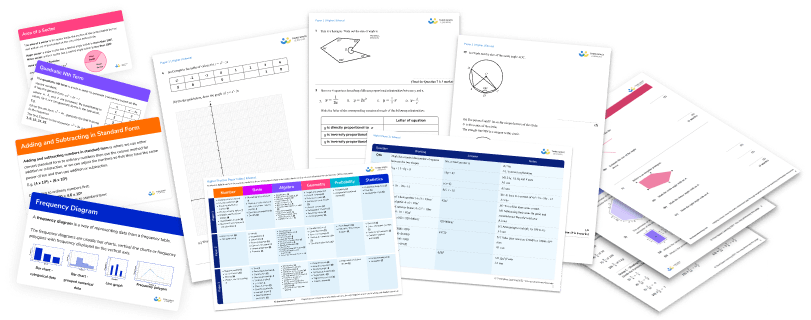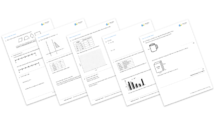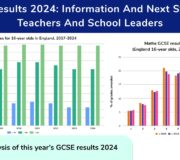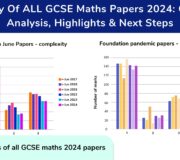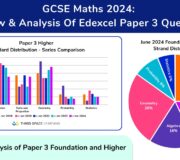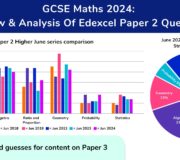How We Developed Our GCSE Maths Revision Programme
In 2021, following a million lessons, and the privilege of teaching tens of thousands of primary students, we launched our maths programmes for secondary students. These programmes continue to support our mission of closing the attainment gap and are delivered in schools through one to one online maths lessons by expert tutors, supporting the work of the classroom maths teacher.
In this article, we hear from Bethan Edwards, Third Space Learning’s Secondary Maths Curriculum Specialist, on how we developed our maths programmes for secondary – the GCSE maths revision programme for those students following the Edexcel, AQA or OCR exam syllabus.
We also have a variety of free GCSE maths revision resources on our website. These comprehensive revision guides are broken down by topic. Our first topic is Algebra, including step-by-step instructions, detailed examples, practice questions, GCSE maths questions, GCSE maths past papers and free GCSE maths worksheets for Factorising Quadratics!
See also: Fluent In Five For Secondary
How did we first develop our GCSE programme?
We are passionate about enabling more GCSE students to reach their full potential in maths and have curated a tailored GCSE maths revision programme to facilitate this.
We wanted to develop a programme that would help support students who need it most, and deliver the most impact in the short timeframe we had. In an ideal world, we would love to have a GCSE revision programme for students at all levels, but for our initial GCSE programme, we needed to decide on a key group that we could deliver the most benefit.
Therefore, the Academic Team chose topics that would be most impactful for students aiming to achieve between a Grade 3 and Grade 6 – with the primary aim of securing most students a Grade 5 or above. We have subsequently produced a programme for students aiming to achieve between a Grade 1 and Grade 3, which is soon to be released.
Read more: How we developed our free GCSE maths revision lesson library
Which GCSE maths topics are taught on the programme?
The programme offers a selection of 36 revision lessons on key topics to support students in attaining a Grade 5 and applicable for all students aiming for a Grade 3 to 6. The aim is to consolidate crucial skills and revision techniques through guided and individual practice whilst also preparing students for exam-style application questions using past paper questions.
We are soon to release 21 more lessons for students aiming for a Grade 1 to 3, bringing the total available lessons to 57.
The maths curriculum we’ve developed is a distillation of three distinct strands in our research:
- frequently occurring topics in past papers,
- content in the ‘crossover’ Higher-Foundation category,
- topics that have been identified as ‘low hanging fruit’ or ‘quick wins’ for students.
Current live lessons:
1. Understanding the basics of fractions
2. Calculating with fractions
3. Estimating calculations
4. Working with fractions, decimals and percentages
5. Working with ratio
6. Expanding double brackets
7. Factorising quadratics (no coefficient)
8. Working with y = mx + c
9. Using Pythagoras’ theorem
10. Trigonometry: Using SOHCAHTOA
11. Working with probabilities in tables
12. Using index laws
13. Solving basic linear equations
14. Forming and solving linear equations (including brackets and fractions)
15. Working with linear sequences
16. Working with prime factorisation (HCF and LCM)
17. Solving area and perimeter application questions
18. Calculating the volume of prisms and cylinders
19. Calculating the surface area of prisms and cylinders
20. Calculating averages from tables
21. Calculating with compound measures
22. Solving linear simultaneous equations
23. Drawing a linear graph from a table of values
24. Finding the area, circumference and lengths of circles, arcs and sectors
25. Calculating compound interest and depreciation
26. Working with standard form
27. Calculating reverse percentages
28. Finding probabilities using tree diagrams
29. Finding angles in polygons
30. Finding angles in parallel lines
31. Finding probabilities using Venn diagrams
32. Identifying parallel and perpendicular lines
33. Drawing a non-linear graph from a table of values
34. Calculating average speed and density
35. Combining and subdividing ratios
36. Factorising quadratics (Higher only)
New Lessons
- Identifying types of number
- Working with powers, squares, cubes and roots
- Working with place value
- Calculating with negative numbers
- Rounding values
- Finding the HCF and LCM using listing methods
- Calculating percentages
- Applying the order of operations
- Identifying properties of 2D and 3D shapes
- Performing transformations of shapes
- Working with simple probabilities
- Converting between measures
- Identifying co-ordinates and midpoints
- Working with simple sequences
- Simplifying and collecting like terms
- Working with inequalities
- Expanding and factorising single brackets
- Working with substitution
- Calculating averages and range
- Drawing and interpreting charts and tables
- Drawing and interpreting scatter graphs
Read more:
- Question Level Analysis Of Edexcel Maths Past Papers (Foundation)
- The Most Impactful GCSE Maths Topics Your Year 10 And Year 11 Should Revise For Their Foundation Exam
- GCSE Intervention Strategies
- GCSE Exams 2022
How do we know this GCSE revision programme is fit for purpose?
Before we rolled out the full programme, we ran a GCSE maths pilot programme in 2021. And since rolling it out, like all of our maths programmes, we have been constantly reviewing and revising elements in response to school, teacher, student and tutor feedback, and our own internal product improvement processes.
Following the initial months of developing, refining and testing all the elements that define the success of our online tuition, we shared our programme. A key component of this process was piloting the programme with our fantastic group of around 9 pilot schools, 170 students and 20 tutors.
We learned a great deal from this development period, and it’s safe to say that the programme you see today is a combination of many individual contributions along the way. We tested everything, from the structure of the curriculum and the progression within each individual lesson, right down to how tutors welcome the students and the diagnostic assessment used before and after each lesson.
Evaluating the first run of the programme, we felt that we needed to switch the focus from ‘learning’ to ‘revision,’ – making the lessons shorter, increasing assessment and ensuring both support and acceleration were provided when required. We changed the programme to address exam questions and mastering exam techniques specifically – and to focus on grasping an overview of a topic in a succinct amount of time.
Here is just one example of the kinds of changes we’ve made:
Pythagoras’ Theorem Lesson : Iteration 1

Agnostic introductory slide where student and tutor discuss how much the tutor already knows.

Guided slide to introduce the first concept to the student.

Guided slide with a worked example pair.


Practice questions for students to demonstrate understanding of the first concept.

Guided slide to introduce the second concept to the student.

Guided slide with a worked example pair for second concept.


Practice questions for students to demonstrate understanding of the second concept.



Exam questions to test student ability to apply understanding.
Pythagoras’ Theorem Lesson : Iteration 2

The introductory slide has become more question-focused in order to:
- Include an assessment point at the start
- Draw out level of understanding
- Limit vague questioning

Exam Question Slide for first concept – used to test understanding of first concept:
- To be used by tutor as an assessment point
- Can they work out what strategies to use?
- Can the student do this alone?
- Yes. Move on to the next exam question.
- No. Move to support and assess slides.

Support slide for first concept – used to explain the concept to student
- Provides guided questioning to reach solution
- Provides student with model answer and scaffolded support
- ONLY completed if the student was unable to do the exam question without support

Assess slide for first concept – used to assess student understanding
- Similar question to supported exam question with the scaffold removed, so student can show what they have learnt

Exam question slide for second concept.

Support slide for second concept.

Assess slide for second concept.

Exam question slide for third concept.

Support slide for third concept.

Assess slide for third concept.

Challenge slide – used to provide additional stretch to students who need it
- Providing an opportunity for the student to demonstrate enhanced understanding
- Bringing in other areas of maths
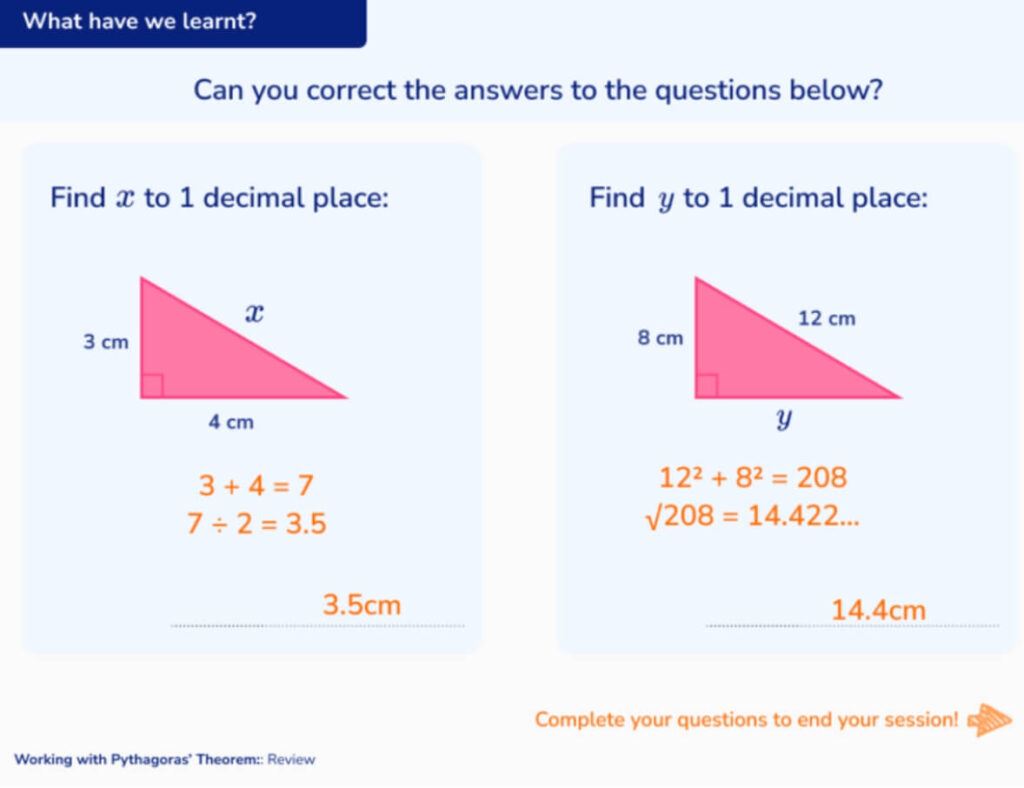
Revision slide – this is used as a final assessment point for the tutor to ensure the student has understood the main concepts and to challenge any remaining misconceptions.
This is followed by the students’ post-session questions which they answer independently. These are used to understand how well students have understood the content of the lesson. The results of these inform which lesson objectives they will move on to and help to personalise their learning journey.
Which students will benefit most from this maths revision programme?
During my time as a secondary school teacher in London, one of the biggest challenges at GCSE was ensuring that students who had been identified as ‘borderline’ for a Grade 4 or 5 went on to achieve these grades in their exams.
“We aim to build both students’ skills and confidence before they enter the exam hall.”
Bethan Edwards, Secondary Maths Curriculum Specialist, Third Space Learning
We work with students from a range of ages and abilities in our secondary schools, and found that this programme is particularly successful with students in categories that will no doubt already be familiar to you:
- Students in Year 11 sitting their maths GCSE for the first time.
- Students who are retaking their maths GCSE in Year 12 or Year 13.
- Students in Year 10 who need a confidence boost or to consolidate key skills.
- Students who are enthusiastic and want to engage with someone, but have significant gaps (for various reasons), and need the space to fill these.
- Students who are apathetic and not attaining highly, whether this is due to a lack of motivation or confidence, but who will benefit from one to one classroom time.
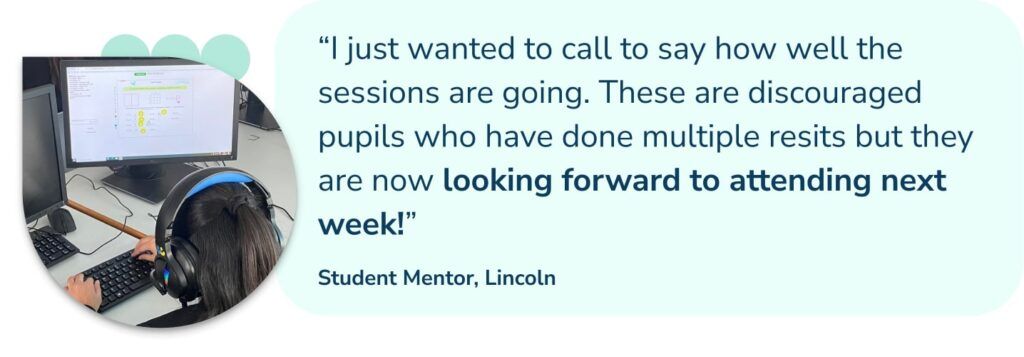
We have now extended this programme to also be appropriate for students who need even more support with the basics – and hope to expand to make the programme applicable to all levels going forward.
Practice Paper Pack: Edexcel Foundation, Advanced Info for Summer Series 2022
Based on the most up to date information on the GCSE Maths topics that will feature on this year's exam, this pack of practice exam papers is a great addition to your revision and will help you prepare for the exam.
Download Free Now!What are students’ motivations for tuition?
Although intervention decisions are usually driven by teachers and the SLT, we are always keen to hear from the students themselves. We asked the cohort from our GCSE pilot programme why they wanted to pursue one to one tutoring:
- “I find maths very hard”
- “I find fractions, decimals and the y and x-axis graphs difficult”
- “I just wish to pass my maths GCSE”
- “I don’t like being distracted while doing a question”
- “My goal is to get a 5”
- “I really struggle with wordy questions”
- “I struggle with most of algebra, especially simultaneous equations”
- “I am really trying to get a grade 5 in maths”
- “A grade 5 would help me get onto my A Level courses”
- “I struggle with ratio”
And since rolling out to schools, students have been similarly engaged with their sessions.
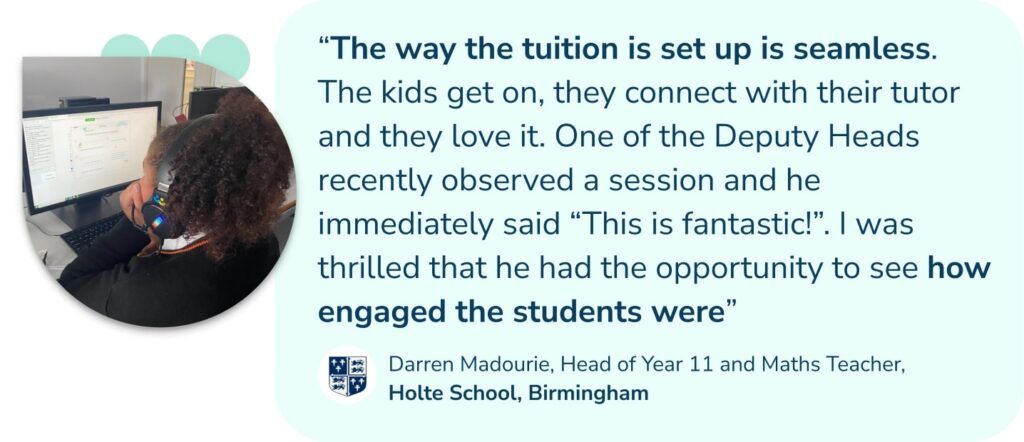
What are the benefits of one to one maths tuition for revision?
The one to one model provided by our online tutoring is beneficial for all levels and all types of students. The model is particularly special because it allows for targeted individual intervention, both through the lessons selected in the diagnostic element of the programme, and the tutors’ regular assessment during a lesson. This in turn allows students to practice specific areas for development identified throughout the session.
Tutoring helps to build confidence, engages students who may otherwise be apathetic or reluctant to participate, and provides time for students with gaps to be inquisitive and develop their knowledge. Pedagogically, tutoring allows students to become more confident in specific areas of need and work at their own pace, as well as receiving instant feedback. Students have tangible opportunities to check their understanding and make progress.
Emotionally, one to one online tutoring takes away the distractions of the classroom, as well as any embarrassment about asking questions. In our low-stakes tuition sessions, students are generally more engaged with the learning process and feel comfortable asking questions about their maths, with a personal tutor who will support them every step of the way.
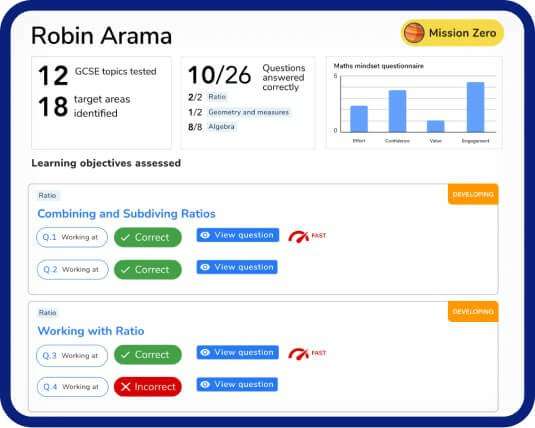
How do secondary students react to our intervention?
It was clear that our well-established primary interventions could not be directly transposed into a secondary context. For example, primary school messaging (such as pictures and smileys) would not necessarily have been appropriate for secondary school.
Our secondary students have been particularly forthcoming in identifying their own areas for development and using tutoring sessions as opportunities to fill their gaps. Having a one to one session each week helps students feel motivated in their maths and gives them a sense of ownership over their learning experience. For example, secondary students have been much more descriptive than at primary in their diagnostic assessments.

How do we use cognitive science in our lessons?
The programme has been designed in line with current educational research and draws on my first-hand experience in schools. It was further developed through user testing.
The diagnostic element of the programme, initiated through a preliminary ‘Mission Zero’ test and continued through ‘Post-Session Questions’ on the taught lesson, and ‘Forward Looking Questions’ on future undiagnosed Learning Objectives, means that students are directed to the lessons which will have the most impact for them.
Our programme asks students about their mindset, confidence and value in maths through Mission Zero. It is also designed to develop metacognition – our tutors ask students to think carefully about what strategies they are going to use, to monitor their progress and to reflect on their learning at the end of each session.
Sweller’s Cognitive Load Theory is carefully considered in the slide design and paired examples are used to support successful tutor modelling. Live tutor notes provide appropriate probing questions to deliver effective assessment and lead to deeper student understanding. Isolating a skill and breaking it down optimises the load on students. The structure of the GCSE programme to test, support, test ensures students are being assessed throughout and their needs diagnosed and targeted.
Tutors are trained in cognitive load and variation theory, and more recently we have embedded Rosenshine’s ‘Principles of Instruction’ into our initial tutor training and continuous tutor development.
Principles such as these now guide our tutors’ practice:
- Present new materials in small steps
- Ask regular questions
- Provide models e.g. example pairs
- Guide student practice
- Check student understanding
- Obtain high success rate
- Scaffold difficult tasks
- Provide plenty of opportunity for independent practice
How are the lesson slides structured?
The design of the slides is intended to be quite flexible. Students who need extra support have plenty at their fingertips, including the whiteboard feature, whereas those who need to be stretched can move on quickly and appropriately (skipping Support and Assess slides for concepts they have already mastered). This means that the same lessons can effectively cater for students of different abilities.
Each of the programme’s lessons features:
- ‘Exam Question’ slides – where students’ current understanding is assessed by asking them to attempt an exam style question
- ‘Support’ slides – where tutors work through the Exam question with student, breaking the question down into parts and guiding the student to reach the solution
- ‘Assess’ slides – where students complete a similar exam style question on the concept, giving them an opportunity to demonstrate their learning and ask any follow up questions
How does diagnostic testing inform what we teach?
The design and format of the programme were created by our Product Team to clearly highlight each section to the student, and bridge curriculum content with usability. This is clearly demonstrated in the power of diagnostic testing, which can decide the priority and order of lessons a student will be assigned so that it is always tailored to students and their individual needs. The teacher also has the option to select sessions themselves if they would like to cover specific diagnosed revision topics.
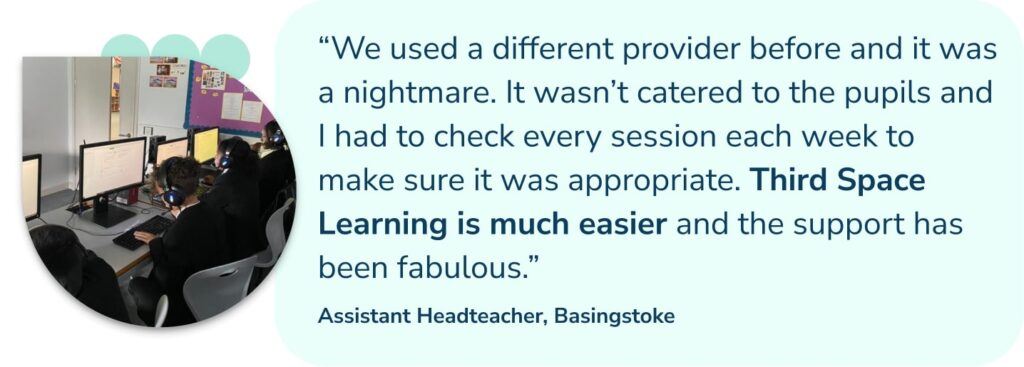
Once the student finishes a lesson, they also complete two ‘Post-Session Questions’, which will assess their ability to apply what they have learnt in a test situation. This ongoing diagnostic testing aims to consolidate understanding and effectively plug gaps.
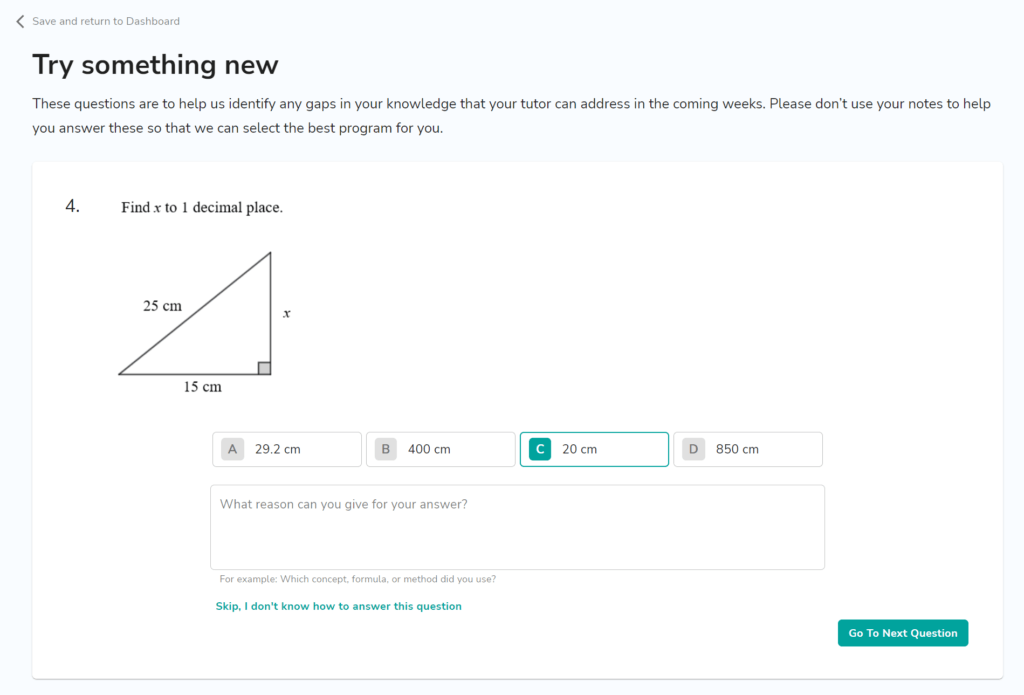
What training have the tutors undergone in preparation for teaching the programme?
All of our online maths tutors undergo a rigorous selection process and training – with live webinars, daily lesson discussions, lesson demos, assessments and GCSE paper studies – so that they are fully confident in the delivery of their sessions.
The initial 3 weeks of training includes an online course I created, which tutors can refer back to whenever they need a refresher. We also asked for feedback on tutor training, so this can be continually refined.
Every tutor has access to detailed lesson guides, thorough tutor notes for each lesson, sample videos, method explanations and discussions. The lesson guides include common misconceptions, example explanations and mark schemes.

Our goal is to make maths tuition accessible for as many schools as possible, and a central solution to this aim is to recruit our tutors from India and Sri Lanka, where there is a huge population of passionate, English speaking students and graduates who love maths.
Being outside of the UK, we take the time in our tutor training – designed by expert UK teachers – to highlight the particular demands of the national curriculum and the pedagogical approaches that are preferred in the UK. This means that our global community of tutors are confident in teaching UK students.
Tutors have also adapted their way of speaking to secondary, ensuring that they pitch their tone appropriately, including considerations for SEN students. In my experience, talking to secondary students naturally and on the same level makes them feel more comfortable and allows tutors to build strong working relationships with students. Students are then more likely to ask questions and feel motivated to join our sessions, where they can value feeling successful. How secondary students learn has been central to the tutor training.
Read more: The Secret To Effective In-School Tuition: The Quality And Training Of Your Tutors
What is next for the maths revision programme?
We are continuing to develop the programme so it can properly cater to the emerging needs of our students. This includes the design of slides, which tutors can suggest edits to via a live form, in addition to more structural elements of the programme.
One of these changes will be engaging students more actively in the diagnostic element of the programme. Currently, their reports go straight to their teachers – which is great for giving the class teacher a map of their students’ individual successes and areas for improvement – but we would love to see students being able to own these too, so that they come into their sessions feeling motivated to make progress in their target areas.
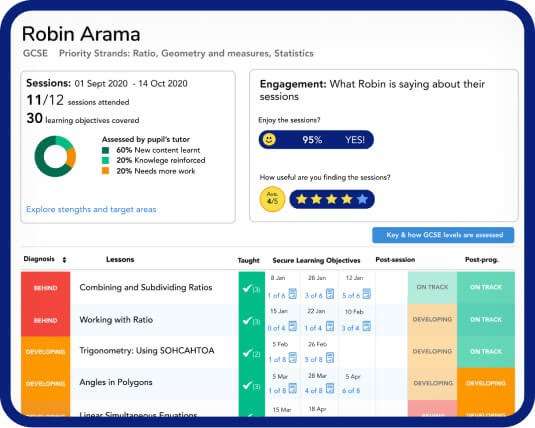
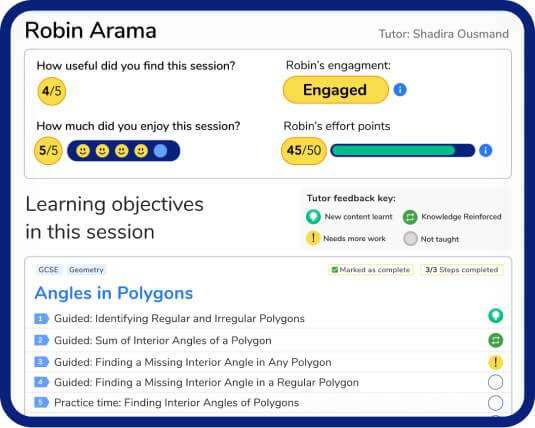
The development of our GCSE programme was a truly collaborative effort between various teams at Third Space Learning. We have utilised our existing expertise in conjunction with new curriculum content and product updates to produce what we hope is a truly valuable GCSE maths revision programme, bolstered by high-quality lessons, tutor training and diagnostic assessments.
We look forward to supporting your students in achieving their target grade at GCSE!
Read more:
DO YOU HAVE STUDENTS WHO NEED MORE SUPPORT IN MATHS?
Every week Third Space Learning’s specialist online GCSE maths tutors support thousands of students across hundreds of schools with weekly online 1 to 1 maths lessons designed to plug gaps and boost progress.
Since 2013 these personalised one to one lessons have helped over 150,000 primary and secondary students become more confident, able mathematicians.
Learn about the GCSE revision programme or request a personalised quote for your school to speak to us about your school’s needs and how we can help.
